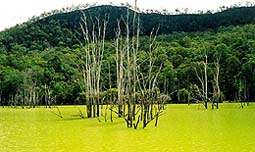Disclaimer: These postings were sent to us from a variety of media sources over the Internet. The content has not been reviewed for scientific accuracy or edited in any manner.
Angling to avoid toxic algae
Overstocking of fish for recreational fishing in Australian lakes and
rivers may unleash blooms of toxic algae, a CSIRO scientist has
warned.
A South Queensland lake that turned a lurid greenish-yellow and toxic has led CSIRO's Dr. Vlad Matveev to question a long-held scientific view that introducing lots of predatory fish can control blue-green algae, through their effect on the food web.
The theory proposes that the big predatory fish eat smaller fish, which takes the pressure off tiny grazing water crustaceans normally eaten by the small fish. Numbers of these tiny grazers increase - and they control the algae by eating it.
Working on a reservoir in South-East Queensland, Dr Matveev found that the theory only works up to a point - and then it can backfire alarmingly, turning the lake a sickly hue and killing wildlife.
"Initially we found that the introduction of bass had the desired effect. They ate the smaller fish, the grazing water micro-crustaceans multiplied. Algae went down. Water quality improved.
"However, as stocking continued, the reverse effect began to appear. For some reason the small grazing water crustaceans went down in numbers, were unable to control the blue-green algae, and a dramatic bloom resulted," he said.
"We think this may be because heavy stocking with large predatory fishes changes the whole food web in the lake, leaving sufficient spare nutrients to trigger an algal bloom."
The scientists checked for other possible sources of nutrients entering the lake - but there had been no flow from feeder streams during the period the bloom occurred.
On the evidence so far, Dr Matveev feels that heavy stocking of lakes and rivers with fish like bass, driven by demand from anglers, can lead to declines in water quality and threats to the health of both humans and wildlife.
"We conclude, that at least for Australian subtropical lakes, the theory developed in the US that big fish can be used to control algal blooms has limited relevance.
"From the results of our study, it would seem that there is a benefit in stocking lakes - but it needs to be done moderately if we wish to maintain their health.
"Overstocking may cause outbreaks of blue-green algae - so we need to manage the fish populations of our reservoirs carefully."
This probably involves establishing a 'threshold stocking density', and setting an upper limit to the population of the big fish favoured by anglers, Dr Matveev says.
This limit may vary from one waterbody to another, and it will be a challenge to work out the best level for each one.
The work was funded by CSIRO Land and Water, Land and Water Australia and the Queensland Department of Natural Resources and Mines.
More information:
Dr Vlad Matveev
CSIRO Land & Water
07 3214 2755
Vlad.matveev@csiro.au
Margaret Bryant
CSIRO Land & Water
08 9333 6215, mobile: 0417 247
241